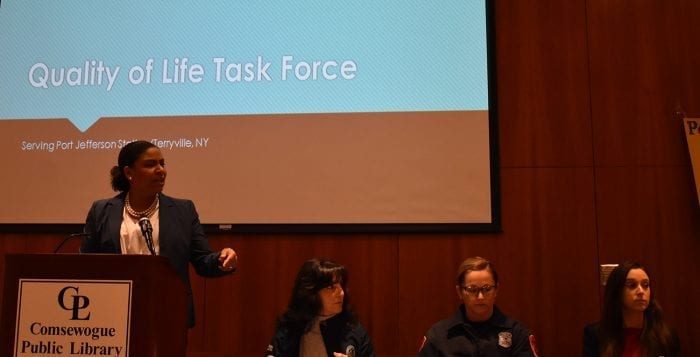As members of the Brookhaven Town’s Quality of Life Task Force walked in to the Comsewogue Public Library Dec. 17, looking to talk about the homeless issue, they were each greeted with a poignant reminder, a shopping cart laden with items, of containers and blankets, sitting in a handicapped space closest to the library’s main doors.
At the area surrounding the railroad tracks in the Port Jefferson area, men and women sleep outside even as the months grow colder. They sleep on benches and on the stoops of dilapidated buildings. Village code enforcement and Suffolk County police have said they know many of them by name, and services for them have been around, in some cases, for decades.
Still, homelessness in the Upper Port and Port Jefferson Station area continues to be an issue that has vexed local municipalities. On both sides of the railroad tracks, along Route 25A, also known as Main Street, residents constantly complain of seeing people sleeping on the stoops of vacant buildings.
But beyond a poor sight, the issue, officials said is multipronged. Dealing with it humanely, especially getting people services, remains complicated, while an all-encompassing, effective solution would require new efforts on every level of government.
Phase two of the task force, officials said, will mean coming out with a full report that includes recommendations, to be released sometime in 2020. Likely, it will come in the form of proposed state legislation regarding access to sober homes, bills to allow assistance in homeless transport, increased sharing of information between departments and municipalities, increased law enforcement activity, and revitalization efforts by both village and town while concurrently tackling quality of life issues.
Efforts by the town
At the Port Jefferson Station/Terryville Civic Association meeting Dec. 17, members of the town’s task force, along with other local legislators, talked with residents about their findings.
The task force came into its own last year after a video of two homeless people having a sexual encounter on a bench in Port Jeff Station exploded in community social media groups like a bag of popcorn heated over a jet engine. The task force has brought together town, police, village, county and other nonprofit advocacy groups to the table, looking to hash out an effective response.
Town Councilwoman Valerie Cartright (D-Port Jefferson Station) said much of the first phase of the task force has been collecting data, although some items still remain up in the air. Vincent Rothaar, of Suffolk County’s Department of Social Services, said there have been approximately 48 street homeless, but he was not sure if that was 48 outreaches to a single individual multiple times.
That is not to say the homeless population in the town’s District 1 and PJ Village is stagnant. Much of them are transient homeless, said PJS/T civic president, Sal Pitti, who is an ex-city police officer. Especially since Port Jeff contains the LIRR Station, those who sleep under a tent one morning may be gone the next day.
“It’s not just an issue that’s affected District 1, it’s an issue that’s affected the entire town, is affecting the entire county” Cartright said. “A lot of the legislation we’re putting forward is not just affecting District 1.”
“It’s not just an issue that’s affected District 1, it’s an issue that’s affected the entire town, is affecting the entire county”
– Valerie Cartright
Cartright has said that several months ago she stood out by the side of the road with a homeless couple that after weeks of talks and persuading finally agreed to go into a Suffolk County housing program. The county had called a cab to pick up the couple, and the councilwoman described how the people had to figure out what they were going to bring with them, going down from several bags between them to one bag a piece.
After calling the cab company, Cartright said the car had apparently got turned around, thinking they were in Port Jefferson instead of Port Jefferson Station. To get the homeless couple their ride, she had to make Suffolk County call up the company again.
Cartright has made efforts to use town-owned buses to help transport homeless individuals in emergency situations but was stymied by other members of the Town Board and officials in the county executive’s office, who said it was both unnecessary and not in the town’s purview.
Rothaar said DSS, especially its recently hired director Frances Pierre, would not dismiss any offer from any municipality of additional transportation services.
“We’re up to working with any government entity for the transport of a homeless person to one of our shelters,” he said. “We’re adamant of not just working with the Town of Brookhaven, but working with every municipality in Suffolk County.”
County offers more collaboration
The difficulty comes in trying to get services for the homeless population comes down to two things, officials said. One is the individual’s or group’s willingness to be helped, the other is the way the county manages the homeless person once they make it into the system.
The difficulty is enormous. Cartright said she has personally talked to individuals multiple times over a year before they even give a hint of wanting to be put in the system.
COPE officer for the Suffolk County police 6th Precinct, Casey Hines Berry, said the police have stepped up foot and bike patrols in the station area, the village and the Greenway Trail, along with talking to increasing communication with local businesses and shelters such as Pax Christi.

“As we were able to determine who were the individuals committing crimes, we could determine who were the individuals who need housing, who have housing, who are refusing housing,” Berry said. “We did this by collaborating all our different resources within the community.”
She said there have been more arrests, specifically 362 from May 2018 to current date, compared to 245 from the previous time period. The disparity of those numbers she attributed to warrants identifying more people in the area who may be wanted for previous citations, especially in quality of life matters such as public urination or open containers. She added there is no gang activity in Port Jefferson Station, only gang-affiliated people living in the area. In May this year, police arrested one young man of Port Jeff Station for an alleged conspiracy to murder two others in Huntington Station.
But police are not allowed to simply arrest people who may be “loitering” on the street without due cause, she said. If a person is standing on private property, it’s up to the owner to call police to ask them for help getting them to move on. In cases where homeless may be living on property such as the LIPA-owned right-of-way, it’s up to that body to request help removing them.
Police know many of the stationary homeless on a first name basis. Getting them to come in to an emergency shelter or through DSS systems is the difficult part. Many, officials said, simply have difficulty trusting the system — or can’t — such as the case when a homeless, nonmarried couple cannot go into services together and would rather stay together than be separated and have help.
Rothaar said the DSS offers much more than emergency housing, including medical assistance, financial services, along with child and adult protective services.
He said department workers often go out to meet homeless individuals over and over. Each time they may bring a different individual, such as a priest or a different social worker, as if “we keep going out to them again and again, they might respond.” He said they have conducted 18 outreaches in the Port Jeff area since 2018 and have assisted 48 people.
“If we continue to reach out to them, they have come into our care, for lack of a better term, to receive case management services,” he said.
Port Jeff Station/Terryville Chamber of Commerce vice president, Larry Ryan, said the best way to give homeless access to care is to be compassionate.
“People have to be willing to accept help,” he said. “You can offer it all you want but if that person’s not willing to take help, or use the services being provided for them, your hands get tied.”
That sentiment was echoed by Pax Christi director, Stephen Brazeau, who said he has seen DSS making a good effort, especially when the weather gets cold. He added that one must be cautious of thinking someone you meet on the street must be homeless.
“You always need to be there, need to always be available when that ‘yes’ comes,” Brazeau said.
Alex DeRosa, an aide to Suffolk County Legislator Kara Hahn (D-Setauket), said the county has already passed legislation, sponsored by Hahn, to allow police a copy of the list of emergency homes that was originally only kept by DSS.
There are more than 200 supportive housing sites in Suffolk County that DSS does not oversee, which are instead overseen by New York State. However, the state does not list where or how many sober homes in the area.
“That’s what we’re trying to change, increase that communication,” said Pitti.
Village works with local shelter
Residents have appeared at village meetings to state they have seen drug deals happening near the LIRR train tracks in Upper Port, specifically surrounding Hope House Ministries, which has provided services for homeless for just under 40 years.
Port Jefferson residents have mentioned witnessing catcalling and harassment on the train platform from people behind Pax Christi’s fence. One resident, Kathleen Riley, said she had witnessed what could have been a drug deal between people using Pax Christi’s back gate to exchange an item that was then taken by people onto a train.
Village officials said they have been in communication with the Pax Christi’s Brazeau. In the past few weeks, village trustee Kathianne Snaden said she has communicated with Pax Christi and has toured their facility along with village manager Joe Palumbo and Fred Leute, acting chief of code enforcement. While she commended the facility for the work it does, she suggested either extending or raising the exterior fence, though Palumbo said he was told they would not be able to take any action on new fencing until at least the new year.
Snaden said the village has also reached out to a fencing company that could create a new, larger fence in between the platform and Pax Christi, in order to reduce sight lines.
Brazeau said the shelter is looking to install a new fence around the side to the front of the building, and has agreed with the village about them installing a higher fence in between Pax Christi and the platform.
Regarding the back gate, he said fire code mandates it be open from the inside, but didn’t rule out including some kind of alarm system at a later date.
MTA representative Vanessa Lockel lauded the new train station to help beautify the area, along with new security cameras for added protection. However, when it came to adding new benches, civic leaders helped squash that attempt. Pitti said they feared more people using the benches for sleeping or encouraging more people to stay and loiter.
Snaden said code enforcement meets every train arriving in an effort to show a presence, which she said has led to a reduction in incidents, though code enforcement is limited in what they can do, with no power of arrest. MTA police, Lockel said, have more than 700 miles of track to cover on the Long Island Rail Road, and not enough people report incidents to their hotline, 718-361-2201, or text [email protected].
Other services available
Celina Wilson, president of the Bridge of Hope Resource Center in Port Jeff Station, has helped identify other nongovernment entities providing services for the homeless population in the area.
She said the two hospitals in Port Jeff, namely St. Charles and Mather, provide similar amounts of service as far as substance abuse, but while St. Charles hosts inpatient detox and rehabilitation services, Mather hosts outpatient alcohol and substance abuse programs.
There are numerous soup kitchens in both the village and station areas, but only two kitchens, Maryhaven and St. Gerard Majella, host food pantries. She said both groups reported to Bridge of Hope there was a decline in people utilizing their services as of a year ago.
Hope House Ministries hosts a range of services for the homeless, including the Pax Christi 25-bed emergency shelter.
“Most people are not aware of the available resources until they are in a crisis,” Wilson said. “And they are scrambling for answers.”
She said largely in the area, “everyone is doing what they are supposed to be doing,” and thanked the local officials for taking action compared to other areas, like Brentwood, whose officials did not make efforts until the situation was already out of control.
“It’s been a wonderful opportunity to work with the members of the task force,” she said.









